In many indigenous cultures of the Arctic region, the Northern Lights have been woven into fascinating folktales and legends.
We would love to share some of them with you, so read on...
 In Norse mythology, the Northern Lights were associated with the god Bifröst, a burning rainbow bridge that connected the realm of the gods, Asgard, with the mortal realm, Midgard. Bifröst was believed to be guarded by the god Heimdall, who was known for his keen senses and watchfulness. It was said that the shimmering lights of the Aurora Borealis were reflections of this celestial bridge, indicating the movements and activities of the gods.
In Norse mythology, the Northern Lights were associated with the god Bifröst, a burning rainbow bridge that connected the realm of the gods, Asgard, with the mortal realm, Midgard. Bifröst was believed to be guarded by the god Heimdall, who was known for his keen senses and watchfulness. It was said that the shimmering lights of the Aurora Borealis were reflections of this celestial bridge, indicating the movements and activities of the gods.
The Vikings believed that the Northern Lights were a manifestation of a battle taking place in the heavens. They believed that the lights were caused by the shining spears and armour of the Valkyries, the warrior maidens who chose fallen heroes to be taken to Valhalla, the grand hall of Odin, the chief god of Norse mythology. The Vikings saw the lights as a sign that a great battle was being fought among the gods, and it was a glorious sight to witness.
The Northern Lights were also seen as a harbinger of good fortune and fertility in Viking folklore. It was believed that if a pregnant woman looked at the lights, her child would be blessed with strength and vitality. The lights were also thought to bring good luck to those who saw them, and Vikings would often make wishes or offer prayers when they witnessed the auroras.
In addition to their mythical interpretations, the Vikings also recognized the practical aspects of the Northern Lights. They used the lights as a navigational aid during their long voyages. By observing the patterns and colors of the lights, they could determine their position and navigate their ships across the treacherous seas.
The Viking folklore surrounding the Northern Lights reflects their deep connection to nature, their fascination with celestial phenomena, and their rich mythological traditions. The lights held both mystical and practical significance, embodying the wonders and mysteries of the cosmos in the eyes of the Viking people.
 According to the Inuit folklore, the Northern Lights were believed to be the spirits of their ancestors dancing in the sky. The Inuit people believed that the lights were created by their ancestors playing a game called “football” with a walrus skull. The skull had been transformed into a glowing ball, and the spirits would kick it back and forth across the heavens, creating the beautiful shimmering lights that we see.
According to the Inuit folklore, the Northern Lights were believed to be the spirits of their ancestors dancing in the sky. The Inuit people believed that the lights were created by their ancestors playing a game called “football” with a walrus skull. The skull had been transformed into a glowing ball, and the spirits would kick it back and forth across the heavens, creating the beautiful shimmering lights that we see.
The Inuit also believed that the Northern Lights had a significant impact on their lives. They saw the lights as a bridge between the human world and the spirit world. It was said that if an Inuit whistled at the Northern Lights, the spirits might come down and take them away to the spirit world. For this reason, children were often warned against whistling at the lights, as it was considered dangerous.
Additionally, the Inuit believed that the Northern Lights could also be a bad omen. They thought that if someone disrespected the lights or behaved inappropriately while they were present, it could anger the spirits and bring misfortune upon the community.
The Northern Lights held a significant place in Inuit culture, symbolizing the connection between the living and the deceased, and carrying a sense of mystery and wonder. Even today, the Northern Lights continue to captivate and inspire people, not only in the Arctic regions but across the world, as a breathtaking natural phenomenon.
 Sámi people, the Indigenous inhabitants of the northern regions of Norway, Sweden, Finland, and Russia’s Kola Peninsula, have rich traditions and beliefs surrounding the northern lights. Their tales and myths reflect their deep connection to nature, spiritual beliefs, and cultural heritage. Here are some key aspects of Sámi stories and myths about the aurora borealis:
Sámi people, the Indigenous inhabitants of the northern regions of Norway, Sweden, Finland, and Russia’s Kola Peninsula, have rich traditions and beliefs surrounding the northern lights. Their tales and myths reflect their deep connection to nature, spiritual beliefs, and cultural heritage. Here are some key aspects of Sámi stories and myths about the aurora borealis:
The Fire Fox Myth
One of the most famous Sámi legends about the northern lights involves the “revontulet” or “fire fox.” The story says that the aurora is created by a magical fox running across the Arctic tundra. As the fox dashes through the snow, its tail sweeps up snowflakes into the sky, creating the shimmering, colorful lights. This tale emphasizes the Sámi connection to their natural environment and the animals that inhabit it, particularly the fox, which holds symbolic significance.
A Connection to the Spirit World
The Sámi often regarded the northern lights as spirits of the dead or ancestors. The lights were believed to be a sign that the spirits were nearby, watching over the living or trying to communicate with them. These beliefs instilled a deep respect for the aurora and a sense of sacredness whenever it appeared.
A Warning of Caution and Respect
The Sámi believed the aurora could be dangerous if disrespected. Children were often warned not to mock, whistle, or wave at the lights. Doing so might anger the spirits, leading to misfortune or even being “taken” by the aurora. To this day, some Sámi families pass down these warnings as cultural teachings about respect for nature and unseen forces.
Portents of Weather or Events
In some Sámi traditions, the aurora was thought to predict the future, particularly in terms of weather or important life events. A bright and lively aurora might be seen as a harbinger of good luck, while a dim or red-tinged aurora might foretell challenges.
The Path to the Afterlife
The aurora was sometimes interpreted as a bridge or pathway to the afterlife. Souls of the departed were believed to use the lights to ascend to the heavens, guided by their ancestors or spiritual forces.
Modern Sámi Reinterpretations
Today, the Sámi people often integrate their traditional beliefs with contemporary understanding of the aurora. Many Sámi individuals and cultural centers share these stories to preserve their heritage, while also celebrating the aurora as a symbol of Sámi identity and the Arctic region.
The Sámi myths about the northern lights reflect not only a deep reverence for nature but also the values of respect, caution, and connection to the spiritual world. These stories have been passed down through generations, keeping alive the mystery and magic of the aurora borealis in Sámi culture.
“The text provided about the myths and tales related to the northern lights is a synthesis of well-documented oral traditions, cultural studies, historical records of beliefs about the northern lights, and modern reinterpretations shared by individuals and researchers.”